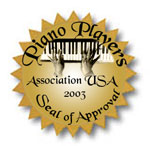| Welcome
to the Spring Recital Piano Concert 2003 Page! |
On Wednesday evening, April 30, 2003, at the Redeemer Lutheran Church in Cupertino, we were privileged to hear some excellent new musicians performing at the piano. The selections ranged from Beethoven and Classical music, to traditional Irish songs and American Blues.

The performers and their performance pieces are listed below; click on the performer's
name or the song title to see the performer's picture. |
Anna Bakker
"Twinkle Twinkle Little Star" |
Norie Omiya
"Sean Sean Leprechaun", "Blues in C" |
Srivas Tirumala
"Sean Sean Leprechaun" |
Roohi Byakod "Ode to Joy"
"Sean Sean Leprechaun" |
Celina McCaffrey
"Little March" |
Ethan Van Steenburgh
"America" |
Natalie Popescu
"Fat Rat's Waltz" |
Tyler Melen
"Caissons" |
Natalia Rivas
"Brahm's Lullaby" |
Udayan Gupta
"The Entertainer" |
| Q:
"Do you know how to get to Carnegie Hall?"
A: "Practice, practice, practice!" |
Manassa Padmanabhan
"Heart and Soul" |
Mary Manchester
"Sean Sean Leprechaun" |
David Strickland
"New York, New York" |
Charles Manchester
"Little March", "Danny Boy" |
"Ode to Joy":
Anna
Bakker, Roohi Byakod, Srivas Tirumala, & Gavin Van Steenburgh |
Chelsea Soldan
"Fat Rat's Waltz", "My Heart Will Go On" |
"Sean Sean Leprechaun":
Norie Omiya, Celina McCaffrey & Roohi Byakod |
Arany Athuyakumar
"Fur Elise" |
"Brand New Blues":
Ciara McCaffrey &
MacKenzie Soldan |
MacKenzie Soldan
"Sonata in F (Pathetique)" |
"Blues in C":
Norie Omiya, Ethan Van Steenburgh, Natalia Rivas, Chelsea Soldan, Arany Athuyakumar, & Tyler Melen |
Ciara McCaffrey
"Shule Aroon" |
|
|
The Story of Twinkle Twinkle Little Star
 Wolfgang Amadeus Mozart was already a famous musician at age 17 when he composed
his variations of a popular 18th century French folk song, “Ah! Vous
dirai-je, Maman”: Wolfgang Amadeus Mozart was already a famous musician at age 17 when he composed
his variations of a popular 18th century French folk song, “Ah! Vous
dirai-je, Maman”:
“Ah! Let me tell you, Mother,
What's the cause of my torment?
Papa wants me to reason like a grown-up.
Me, I say that candy has greater value than reason.”
The MIDI file you hear playing when you open this webpage is
an excerpt of these variations by Mozart from 1773 which may have inspired the tune’s use by Jane Taylor in
1806. Here are her famous lyrics:
“Twinkle, twinkle, little star, How I wonder what you are.
Up above the world so high, Like a diamond in the sky.
Twinkle, twinkle, little star, How I wonder what you are!
When the blazing sun is gone, When he nothing shines upon,
Then you show your little light,Twinkle twinkle all the night.
Twinkle, twinkle, little star, How I wonder what you are!
Then the traveler in the dark Thanks you for your tiny spark;
He could not see which way to go, If you did not twinkle so.
Twinkle, twinkle, little star, How I wonder what you are!”
|
 The Story of Ode to Joy The Story of Ode to Joy
Ludwig Von Beethoven was inspired by German poet Friedrich von Schiller's poem,
“Ode to Joy” (English translation):
“Joy, beautiful radiance of the gods, daughter of Elysium, we set foot in
your heavenly shrine dazzled by your brilliance. Your charms reunite what use
has harshly divided: all men become brothers under your tender wing”.
Beethoven set these words to music in his famous Symphony No. 9. At its first
performance, in Vienna on May 7, 1824, Beethoven could not hear the shouts of
"Bravo" (or his own music!) as he was completely deaf by this time. The choral
“Ode to Joy” was the finale song for the opening ceremony of the 2002 Winter
Olympics at Salt Lake City, Utah.
|
The Story of Brahm’s Lullaby
 Johannes Brahms wrote “Cradle Song”, a variation on an Austrian folk song
for the first child of a friend in Vienna. It is one of the “Five Songs (Opus 49)”
that he composed in 1868. It has since become known as “Brahm’s Lullaby”.
Brahms admired and drew inspiration from Beethoven. He also composed popular
variations of Hungarian gypsy music. And “Brahm’s Lullaby” is, of course, one
of the most popular tunes of all time for millions of wind-up music boxes and
teddy bears. Johannes Brahms wrote “Cradle Song”, a variation on an Austrian folk song
for the first child of a friend in Vienna. It is one of the “Five Songs (Opus 49)”
that he composed in 1868. It has since become known as “Brahm’s Lullaby”.
Brahms admired and drew inspiration from Beethoven. He also composed popular
variations of Hungarian gypsy music. And “Brahm’s Lullaby” is, of course, one
of the most popular tunes of all time for millions of wind-up music boxes and
teddy bears.
|
 The Story of The Entertainer The Story of The Entertainer
Scott Joplin grew up in midwest USA. He played banjo and piano in saloons like
the Maple Leaf Club in Sedalia, Missouri. His famous song, “Maple Leaf Rag”
(1899) was followed by “The Entertainer” (1901). His “ragtime” style of music
often uses clever syncopation (notes alternating quickly between left and right hand parts).
He also helped legitimize and popularize "blues" and
"12 bar" song forms. Scott's music became
popular as background music for TV and films from the 1950s
on. His song, “The Entertainer” earned an Academy Award for its use in the 1973 movie “The Sting”.
|
|
Fall
Recital 2001 Spring
Recital 2002 Fall
Recital 2002 |
|

"Sean Sean Leprechaun", "Little March", "Fat Rat's Waltz", "Brand New Blues", and "Blues in C", ©2003 by Paul Alan Smith
Redeemer Lutheran Church and
SweetMusik Studios are both located in Cupertino, CA |
|
Piano Instructor - Paul Alan Smith
http://www.musicandlight-unlimited.com/recital2003 |